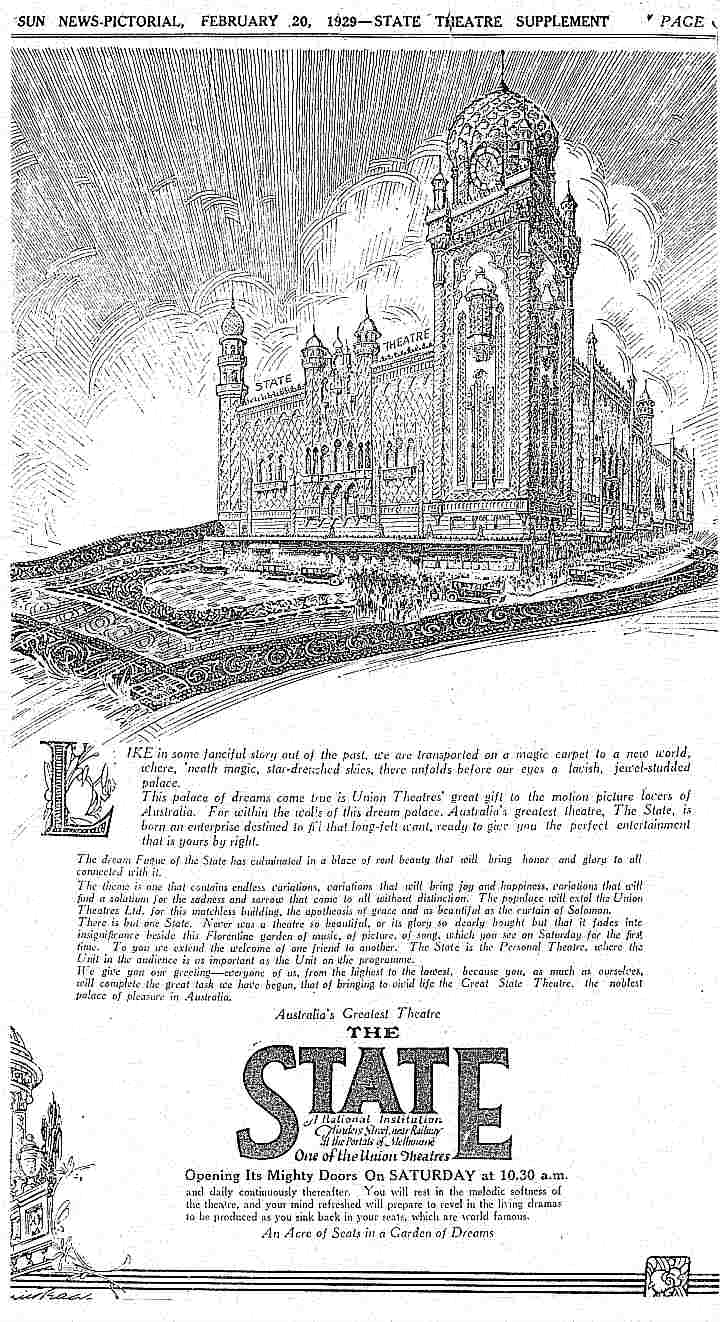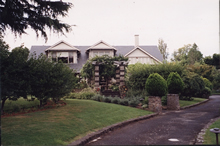You can find them in every city.
Tucked away on a back alley or down a one way side street, or sometimes out in the open, hiding in plain sight; the city's unique architectural wonders.
In Melbourne, one of the most prominent of these is the 'The Forum Theatre' on Flinders Street. And it seems fitting that this building, with its mock Moorish turrets, elaborate facade, opulent lobby and exotic, faux Greco-Roman theatre, has a history every bit as interesting as its design.
Built across 1928-29, the State Theatre (as it was originally called) was designed by American architect John Eberson and built for Greater Union Cinemas. Eberson, a Ukrainian who had studied design in Vienna before moving to America, was a leading architect of the period, renowned for his theatre designs. He designed more than a hundred theatres and cinemas in his career, including the magnificent State Theatre in Sydney:
 |
| Atrium - State Theatre Sydney |
 |
| State Theatre Melbourne, construction site, 1928 |
The State Theatre in Melbourne was designed as a one screen cinema, with stall seating on the ground floor and a dress circle above. The interior featured statuary and columns reminiscent of classical architecture, as well as a ceiling designed to mimic the night sky (features that have been retained to this day).
The capacity of the new venue, 3371, made it the largest theatre in Australia at the time.
 |
| The State Theatre exterior, shortly after completion, in 1929 |
 |
The lobby, in 1929, which still looks much the same today.
|
 |
| The view from the stage in 1929, before the theatre was split. |
As well as the expensively appointed interior and exterior, the theatre also boasted another feature when it opened; the largest organ in the world, outside of the United States.
Purchased by special order for the staggering sum of 25 000 pounds, the Wurlitzer 270 traveled to Australia from the US by boat, arriving early in 1929. It was so large that 27 lorries were required to transport it from the dock to the theatre, the resulting convoy causing such a disruption to traffic on Flinders Street that the theatre's owners were fined by the local council (and thus bought themselves invaluable publicity).
The organ required two musicians to operate it; one seated to the left of stage on a 'master' console, another to the right on a secondary, or 'slave,' console.
 |
| Forum Theatre stage in 1929, with both organ consoles visible. |
For the theatre's much hyped opening season, Greater Union brought out acclaimed American organist Frank Lanterman, previously of the Metropolitan Theatre in Los Angeles. A local musician, Arnold Coleman, was engaged to fill the 'slave' chair (although a different musician, Rene Lees, would perform on opening night).
Lanterman would return to America after a year playing at The State (and would later be elected to California's state legislature) leaving Coleman to take over as head organist, a position he would fill until 1940. Coleman would gain some measure of fame in Australia through a regular series of Sunday afternoon concerts he would perform, broadcast nationwide on the ABC live from The State.
Finally, everything was in place for the theatre's opening night.
 |
Advertisement from 'The Sun' promoting opening night.
|
Giving an indication of how the theatre would be utilised during its initial span of operation, the opening night at The State offered a mixed program; a silent feature, some shorts, some newsreels and live music (with a thirty piece orchestra alongside the organ). Local publication 'Everyman's' reviews the night:
This successful opening set the tone for the theatre for its first decades. Little would change in the way the theatre was utilised until after the Second World War.
In the 1950's public taste began to change and, with that, changes would also be seen at The State. The live music program was discontinued and the organ fell into disuse. Similarly, the rise of television meant the end of newsreels and a refocusing of cinema programming to shorts and features.
 |
| The State in 1962, shortly before it was split into two cinemas. |
Following an American trend towards multi-screen cinema's showing a greater variety of movies, Greater Union would split The State into two separate cinemas in 1963. The dress circle was enclosed, given it's own screen and dubbed 'The Rapallo,' while the larger downstairs theatre was renamed 'The Forum' after it's still elaborate decoration. This was the first instance in Australia of a single screen cinema being split into two smaller venues.
The massive Wurlitzer was removed, with some difficulty, and sold to a private collector, Gordon Hamilton. (the organ pit was converted into a milk bar). Hamilton stored the instrument for several years and then, unable to afford a restoration himself, re-sold it to Morabbin City Council in 1967. It was installed at Moorabbin Town Hall and a painstaking restoration was undertaken by the council (an estimated 8 000 work hours were needed to return the instrument to full playing order). The organ was unveiled in 1970 for a series of sold out public concerts and is still used by the council to this day.
 |
| The organ finds a new home. |
In 1981, Greater Union would again rename the old State Theatre.
 |
| The Forum, early 80's. |
Now the entire venue would be known as 'The Forum,' with the individual cinemas re-named 'Forum 1' (upstairs) and 'Forum 2' (downstairs). But the upkeep on such an old building, and the cinema industry's continued drive towards larger complexes with multiple screens, meant The Forum had become unprofitable. The cinema closed in 1985 and the building was sold, ending a near 60 year unbroken run as one of Melbourne's most striking public venues.
From 1985, The Forum would adopt an entirely new and very different function, as the headquarters of 'Revival Centres International' (RCI).
RCI was a Pentecostal church, founded in 1958 in Melbourne, that had been having difficulty finding a building suitable for administrative and church business. In 1966, the church had purchased a large property in Harcourt Street, Auburn, known as 'Carn Brae,' to this end.
 |
| Carn Brae. |
But a church proposal to add a substantial meeting hall to the property had met with local opposition, leading to a public protest. Building approval for the hall was eventually denied, leaving the church still wanting a larger property to expand into. The Forum Theatre, rundown and relatively cheap but still prestigious, seemed perfect for this purpose.
RCI would use the theatre as a meeting place for a decade.
But in 1995, a doctrinal split would fracture the church, and split the congregation into two main groups. This, plus the continued high cost of running the building, lead to the church selling the property that year.
This time it was purchased by entrepreneur David Marriner, whose Marriner Group paid for significant restorations to the theatre in the second half of the 1990s. Since this time, The Forum has been used for a variety of purposes, most notably live music, comedy and as one of the venues for the Melbourne International Film Festival, and so has moved some way back towards it's hey day.
Throughout it's ups and downs, and various owners, The Forum has remained one of Melbourne's most impressive buildings, and an innate part of the inner city landscape.













Thank you. I've often wondered about the history of this magnificent building but never had a chance to find out more about it until now.
ReplyDeleteThanks for reading. It's a great story and still such a beautiful building.
ReplyDeleteFantastic - thanks for a great resource - Hosier Inc
ReplyDeleteand now a year and bit later, a proposal to restore it (well the outside anyway) but in return for a hotel next door three times the height limit !
ReplyDeleteI haven't been inside it since the cinema closed down. I'd love an excuse to go back inside. The place is breathtakingly beautiful. Amazing to think it was built especially as a cinema!
ReplyDeleteHopefully something nice will happen, unlike the gorgeous Astor cinema, which was built around the same time and is now closing down due to things beyond the control of its fans. :-(
A letter of January 1929 from the Victorian Operative Bricklayers' Society to the Building Trades Federation called their attention "to the large number of Accidents that have happened on the State Picture Theatre".
ReplyDeleteSo there was a cost to the race to finish in a hurry, something probably not documented in any other history.
I used to go every day to work as an usherette at the State Theatre. I loved it there and when Aubrey Whealen played the Wurlitzer it sent shivers down my spine. I t
ReplyDeletewas so beautiful. !!